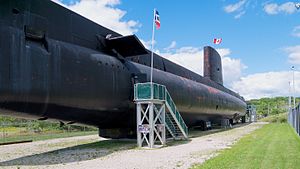 HMCS Ojibwa as museum vessel in Port Burwell, Ontario.
| |
| History | |
|---|---|
| Name | Onyx |
| Builder | Chatham Dockyard, Chatham |
| Laid down | 27 September 1962 |
| Fate | Sold to Canada while under construction |
| Name | Ojibwa |
| Namesake | Ojibwa First Nations people |
| Launched | 29 February 1964 |
| Acquired | 1963 |
| Commissioned | 23 September 1965 |
| Decommissioned | May 1998 |
| Identification | S 72 |
| Fate | Transferred to Elgin Military Museum 2 December 2011 |
| Status | Museum ship at Port Burwell, Ontario since 2013 |
| Badge | Blazon Azure, an escallop shell erect argent irradiated by nine ears of wild rice or, all issuing from two barrulets wavy of the last, in base.[1] |
| General characteristics | |
| Class and type | Oberon-class submarine |
| Displacement |
|
| Length | 295.25 ft (89.99 m) |
| Beam | 26.5 ft (8.1 m) |
| Draught | 18 ft (5.5 m) |
| Propulsion |
|
| Speed |
|
| Range | 9,000 nautical miles (17,000 km; 10,000 mi) at 12 kn (22 km/h; 14 mph) |
| Endurance | 258 t of oil, 56 days |
| Test depth | 120 metres (390 ft)-180 metres (590 ft) |
| Complement | 69 |
| Sensors and processing systems |
|
| Electronic warfare & decoys | MEL Manta UAL or UA4 radar warning |
| Armament | 8 × 21 in (533 mm) tubes (6 bow, 2 stern), 30 torpedoes |

HMCS Ojibwa is an Oberon-class submarine that served in the Royal Canadian Navy (RCN) and later the Canadian Forces Maritime Command (MARCOM). Originally intended for service with the British Royal Navy as HMS Onyx, the submarine was transferred to Canadian ownership before completion, and entered RCN service in 1965. Ojibwa operated primarily with Maritime Forces Atlantic until her decommissioning in 1998. In 2010, Ojibwa was laid up at CFB Halifax awaiting disposal, with the Elgin Military Museum planning to preserve her as a museum vessel. The submarine was towed to Port Burwell, Ontario in 2012, and was opened to the public in 2013. She is now the new focal point of a planned Museum of Naval History to be built alongside.
- ^ Arbuckle, p. 77